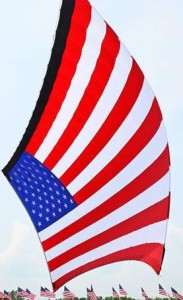“The Tour de France is very popular in Europe,” David Milburn said, “but here in the United States a biker pedaling alongside the road is considered ‘a nuisance.’”
Too many get mad at bicyclists, ride up on the biker’s rear wheel, flash lights, hit the steering wheel, and honk, furious that the biker is “in the way.”
Frederick Lonas lived in Purcellville, and rode his bike all over the area. Then he moved with his wife to Grants Pass, Oregon. But he still rode his bike every day. It kept him fit. No question it was energy efficient.
“In his early 70s, Fred rode his bike back from Grants Pass to Virginia to visit family and friends,” said David.
“Fred said the part of his cross-country trip that concerned him,” according to David, “was those mid-west logging trucks; it’s because they don’t give a shit. That’s what Fred said.”
What does it take for a car or truck to watch out, and go slow for 40 seconds, to give a three foot berth, before speeding off? Too few appreciate that life has a speed limit.
“Fred was in the insurance industry, at Mutual of Omaha, and studied risk,” said David, “and when he lived here in Purcellville, I’d often see him on the bike trail. He’d always have on his orange yellow vest. He wore flip flops with socks over them, as his bike shoes. He kept a steady pace, about 10 miles an hour, slower than mine, but, when I saw him at Starbuck’s, I’d always say, so everyone could hear, how he passed me. Fred enjoyed my kind obeisance.”
“We’d sit around at Starbuck’s, Fred wearing his riding shorts, one leg over the arm of the chair,” said David, “and he’d hold forth on all manner of issues, discussing everything you could imagine with Mark Levit, myself, and whomever came over. Then, coffee and conversation done, Fred would ride back from Leesburg to Purcellville on his bike.”
“Fred was last here a few weeks ago, he was 75 this trip,” said David, “he was getting ready to ride back to Grants Pass in Oregon from Leesburg. That’s a ride of more than 2,500 miles.”
Before he set out for Oregon, Fred said, “I’m so proud that my granddaughter painted my nails. I’m keeping them just as they are until I get back to Oregon, to show ‘grandma.’”
“Fred would stop along the way, observe the sights, stay at hostels,” said David, “so some days he’d make 50 miles, other days about 100.”
But on July 11, 2015, driving through Stutsman County, North Dakota, having biked about 1,500 miles, and traveling West on N.D. Highway 46, 10 miles short of US Highway 281, at about 6:35 pm, Fred was overlooked.
A 2007 400 horsepower Freightliner, weighing about 18,000 pounds, with a Reinauer flatbed trailer, struck Fred riding his bike on the far right of the westbound lane.
Fred was thrown into a ditch. The impact had to be bone crushing, instantaneous and unimaginable pain. Fred was likely dead before he hit the dirt. He was wearing a helmet, and his brightly colored vest, but that Freightliner driver didn’t give a shit.
Mark found the clipping in the Jamestown Sun, walked up to people in Starbuck’s who knew Fred, and asked, “Did you hear?” No one had.
“He was an amazing guy,” David said.
Drivers around here begrudge bikers that fraction of a minute delay they “endure” to pass a biker “in the way.”
Well, Fred’s no longer “in the way” because another driver didn’t care enough.




